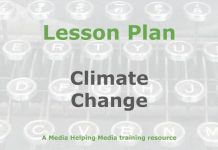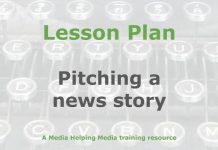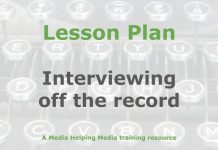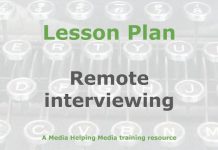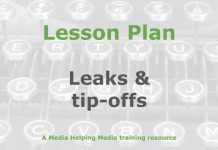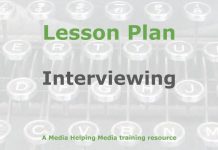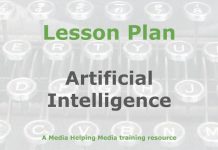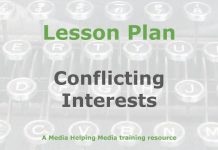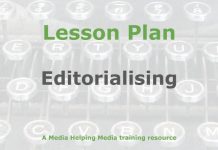 This lesson plan is designed to help students understand how to construct a news report so that it is easily understood by the reader.
This lesson plan is designed to help students understand how to construct a news report so that it is easily understood by the reader.
It’s based on the article How to create a structured news report which is published on Media Helping Media. We recommend you read the article before adapting this lesson plan.
Learning objective
Students will construct a comprehensive news story plan by identifying and organising the main elements such as the headline, the lead, the main body text, and the conclusion. They will evaluate the completeness and coherence of their story plan by ensuring that all necessary components are included and that they are ordered in a logical manner.
In this lesson plan the term headline refers to the title of the story. The lead is the first paragraph and is sometimes called the summary or stand-first. For the purpose of this training session we will use headline, summary, body text, and conclusion.
- Student-facing objective: By the end of this lesson the student will be able to create a detailed plan for a news story, making sure all important parts are included and that they are in the right order.
- Standards: Students will learn the best way to construct the elements of news story and in doing so improve their news writing skills and the informational value of the news articles they produce.
Learning activities
Warm-up
Notice and wonder: Display a short, simple news article headline and summary. Ask students, “What do you notice? Give them a few minutes to think and discuss with a partner. Then, select a few students to share their observations and questions. Record these for all to see. Guide the conversation towards identifying the main elements of a news story in order to prepare them for constructing a story plan.
Direct instruction
- Introduce story elements: Explain the components of a news story: headline, summary, body, and conclusion. Use a real-world example, such as a recent news article, to illustrate each part. Highlight how the headline captures attention, the summary sets the scene, the body provides details, and the conclusion wraps up the story. Discuss the importance of each element in creating a coherent narrative.
- Story planning process: Describe the process of creating a story plan. Emphasise the need for an outline to organise thoughts and ensure all necessary elements are included. Use a simple analogy, such as building a self-assembly model, to explain how each piece (interview, data, quotes) fits into the overall story. Provide a basic template for students to follow, outlining where each element should be placed.
- Identify missing elements: Present a partially completed story plan. Ask students to identify missing elements and suggest where additional information is needed. Encourage them to think about potential sources for missing data, such as interviews or research. Facilitate a discussion on how to address gaps and enhance the story’s impact by exploring different angles.
Guided practice
Think, Pair, Share: Guide students through a collaborative exercise to reinforce story planning skills.
- Think: Ask students to individually draft a brief story plan using a provided template. Include a headline, summary, body, and conclusion.
- Pair: Have students pair up to exchange their story plans. Each student should review their partner’s plan, focusing on identifying missing elements or areas for improvement.
- Share: Invite pairs to share insights with the class. Encourage them to discuss common challenges and effective strategies for completing a story plan. Record the main points on the board.
- Revise: Ask students to revise their story plans based on feedback received during the pair and share phases.
- Reflect: Facilitate a brief class discussion on the importance of collaboration in journalism. Highlight how peer feedback can enhance story quality and coherence.
Independent practice
- Story plan creation: Instruct students to independently create a detailed story plan using the provided template. Ensure they include a headline, summary, body, and conclusion.
- Self-assessment: Ask students to review their story plan against a checklist of elements. Encourage them to identify any missing components or areas needing improvement.
- Peer review: Pair students to exchange story plans for peer review. Each student should provide constructive feedback on their partner’s plan, focusing on completeness and coherence.
- Final revision: Direct students to revise their story plans based on peer feedback. Encourage them to refine their plans for clarity and impact.
Assignment
Ask students to answer these questions on their way out:
- What is the most important element of a news story plan, and why?
- How does having a story plan help in constructing a news story?
- What’s one question you still have from today’s lesson?
Here are some suggested answers:
- Suggested answer to Question 1: The lead is crucial because it captures the reader’s attention and sets the tone for the story.
- Suggested answer to Question 2: A story plan helps organise thoughts, ensures all necessary elements are included, and guides the logical flow of the story.
Teacher resources
Differentiation guide
- Advanced learners: Encourage them to explore complex story angles or incorporate multiple perspectives. Suggest they analyse a professional news story to identify advanced techniques in structuring and storytelling. Challenge them to create a story plan with a unique narrative style or voice.
- Striving learners: Provide additional scaffolding, such as a more detailed story plan template with guiding questions. Offer examples of simple news stories to illustrate basic structure. Pair them with peers for collaborative planning and feedback. Use graphic organisers to help them visualise story elements and their connections.
- Background reading: We recommend reading the article How to create a structured news report which is published on Media Helping Media before adapting this lesson plan.
Notable definitions
- Headline or lead: The opening section of a news story that captures the reader’s attention and provides the most important information.
- Summary, stand-first, or intro: The first paragraph that appears directly below the headline, summarising the main points of the story and essentially acting as a bridge between the headline and the main body of the article
- Body: The main part of a news story that contains detailed information, including facts, quotes, and data, supporting the lead.
- Conclusion: The closing section of a news story that wraps up the narrative and provides closure or a final thought.
Required materials
- Story plan template: Provide a simple template for students to organise their story elements.
- News article example: Use a recent news article to illustrate story components.
- Whiteboard/markers: For recording observations and main points during discussions.
- Checklist: A list of key elements for self-assessment and peer review.
- Writing materials: Paper and pens for drafting and revising story plans.
- Timer: To manage time during activities and transitions.
Lesson summary
- Warm-up
- Direct instruction
- Guided practice
- Independent practice
- Assignment
The free teaching tools at the Khan Academy were used in the production of this lesson plan.
Related articles
